Cannabis enthusiasts recently showed quite a surge of newfound interest for cannabis bonsai trees, so I’ve decided to cover this topic in vigorous depth.
Before starting the tutorial, we should probably say something about the bonsai culture first, in order to have a better comprehension of why would someone start to grow their own marijuana bonsai tree.
Lasting for more than a millennia, the subtle art of grooming miniature-sized plants originated in ancient Japan (and this tradition is closely connected to their Zen Buddhism practices), but the roots of this custom actually originated in old China.
The end-goal of growing a bonsai tree is to create an authentic plant that appears identical to the ones that can be found in nature, with the sole difference being the actual size of the tree.
It’s important to note that bonsai’s aren’t genetically tampered to become smaller in size, and actually any kind of tree could be used for creating a bonsai.
Naturally, some species are far more suitable for this than others.
The word bonsai (when directly translated from Japanese) means “planted in a container”, and this is very true to the heart, because once the plant is grown in a small container, this will limit its ability to store large amounts of nutrients and to have a large root system, and these limitations are the most important aspects of growing a bonsai tree.
In order for the bonsai to turn out as perfect as it can be, plants that have a woody trunk should be used, and preferably ones that have smaller leaves by default, or plants that have reducible-size leaves.
Cultivating a healthy bonsai tree involves a lot of pruning, branch-wiring, limiting the quantity of fertilizers and many other precise details, which makes bonsai cultivation a very time-consuming and demanding task, but that is (besides a gorgeous looking plant) the most rewarding thing about bonsai culture.
There are a few critical factors to consider when selecting seeds for a cannabis bonsai tree.
Firstly, you may want to consider using feminized seeds, as they will ensure that your tree will produce buds rather than pollen sacs, which can detract from the plant’s appearance and also reduce its potency.
You may also want to consider using autoflowering seeds, which help to grow smaller and more compact trees, making them ideal for bonsai cultivation. Autoflowering strains also have a shorter growth cycle, which can be advantageous for those looking to produce multiple bonsai trees in a short period of time.
The choice between sativa and indica plants really depends on individual tastes and the growing conditions available. Indica strains are shorter and bushier, making them ideal for bonsai cultivation. They also have a relaxing, sedative effect, which can be beneficial for those who use cannabis medicinally. Sativa strains, on the other hand, are taller and slimmer, and have a more energizing, uplifting effect. Finally, the choice between indica and sativa will come down to personal preference and the desired effect.
Pay attention to all recommendations and check trusted seed sellers on https://askgrowers.com/seeds to choose the best option for your cannabis bonsai tree.
The same Zen-like philosophy could be applied when we are nurturing a new cannabis bonsai tree, because the sheer time and effort you put into this living thing will result in a more personal and engaging relationship with your plant, and the time spent working on it will be filled with peace and serenity.
So now that we’ve gotten acquainted with the history and the fundamental characteristics of the bonsai tradition, we can move on to the practical part of this piece.
How to grow a cannabis bonsai tree from scratch
In order to cultivate your own canna-bonsai, you’ll be needing a couple of things:
- A young cannabis plant in a pot (here’s how to grow it indoors)
- Electric drill
- Plastic-covered wire (or gardening twine)
- A wooden stake (don’t worry, there are no vampires involved)
Phase One – Drilling the Pot
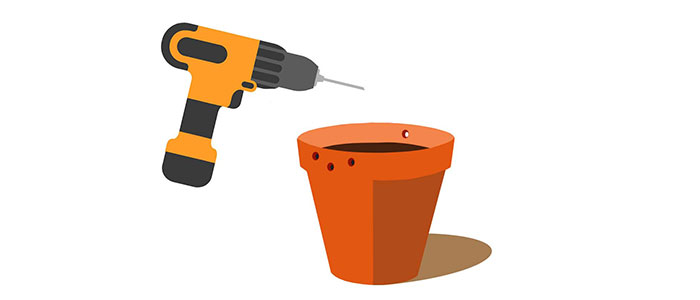
Start by drilling numerous holes from all sides of the pot, and through them you’ll be running the wire (or twine, depending on your personal preference) to suspend the branches of your canna-bonsai in any desired direction.
Double check that the holes you’ve drilled are wide enough for the wire or twine, so you don’t have to waste any time broadening them afterwards.
Phase Two – Trunk Training
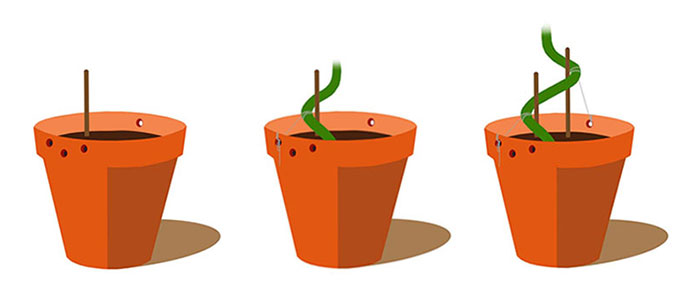
The most important aspect to get your cannabis plant looking like a bonsai tree is to stick a wooden stake next to the trunk.
You’ll use the stake to position the trunk in any direction you wish, which will give your plant that unusual exotic appearance.
To avoid any possible root damage, very gently press the wooden stake down into the soil alongside the trunk of your plant, and once you’ve wrapped the trunk the way you wanted to, tie it with wire or twine to one of the nearest holes that you’ve previously drilled in the pot.
Make sure you don’t tie the trunk with too much force, and always leave some extra room for the trunk to expand in size.
Phase Three – Branch Training
The next thing needed to be done is tying the branches of your plant.
This is achieved in the same manner as with the trunk, so when you envision in which direction you want your branches to go, tie them with wire and connect them with the holes you previously drilled in the pot.
Again, make sure you leave some extra room while wiring, so your branches can grow uninterrupted and without excessive constriction.
If you want your branches to be more horizontal, tie them down with more force, and if you want them in a more traditional vertical style, keep the bondage of that branch light.
Phase Four – Branch Pruning
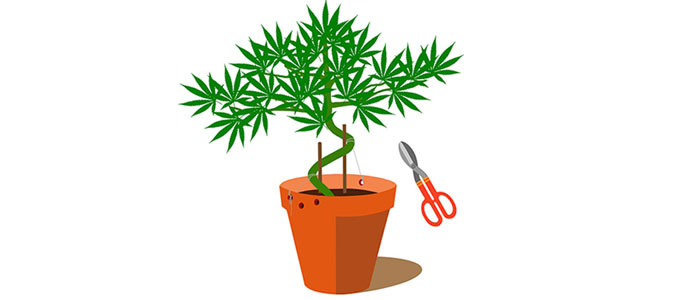
As your canna-bonsai develops and becomes bigger, you’ll need to limit the number of branches by pruning them.
This will preserve that custom bonsai look, but at the same time it’ll preserve an optimal amount of airflow to your plant, preventing it to become too humid and develop any mold.
Just make sure you only prune the new offshoot branches, because you definitely don’t want to cut any important ones, as this will slow down the growth of your plant to a great extent.
Phase Five – The Harvest
Once your canna-bonsai reaches the flowering stage (you can determine this by viewing the trichomes on your buds), and when they turn creamy white, it’s time to snip them off.
Leave the fresh buds in a ventilated room to dry off, and once you can separate the stem easily from the branch, it’s time for curing.
To properly cure a bud you’ll need an airtight glass jar. Place the buds in the jar and place your jar (or jars) in a dark dry space.
Double check that the buds don’t get too humid, and if that happens, just air out the jars and close the lid again.
You’ll recognize the end of curing once your buds become half dry (with the trichomes remaining still quite sticky), and in this phase you can start to puff your product.
Even now when it’s completely budless, you canna-bonsai will be a living breathing work of art.
It is also possible to keep your canna-bonsai alive for the next, and all other seasons to come. Let’s show you how you can extend the life of your plant, so it flowers for many years.
When the bonsai is ready to be cut, remove the top ⅓ of the plant (this is the area where all the massive buds will be).
The middle (or central) ⅓ of the plant needs to be heavily trimmed, and all the yellow old leaves should be removed.
And for the lower ⅓ of the plant, you shouldn’t remove the small buds from this section, because they are paramount for provoking the regeneration process.
Once you’ve completed all of this, it’s time to set your canna-bonsai into vegetative state, which means 18+ hours of light plus a substantial amount of nitrogen for kick-starting the vegetating phase.
Also note that your plant won’t require so much water as it did during the flowering phase, so water it once and repeat once it’s dry.
The regeneration will do wonders for the look of your canna-bonsai, because you won’t have to start nurturing a new one every time you harvest your buds, and believe me, they will only get more beautiful with time.
Unfortunately it’s possible that there will be a decrease in the potency of your buds after every flowering, but because the end-goal of a canna-bonsai isn’t really the punch your buds can deliver, but the time and effort you put into cultivating it, and a wonderfully intricate design of your plant.
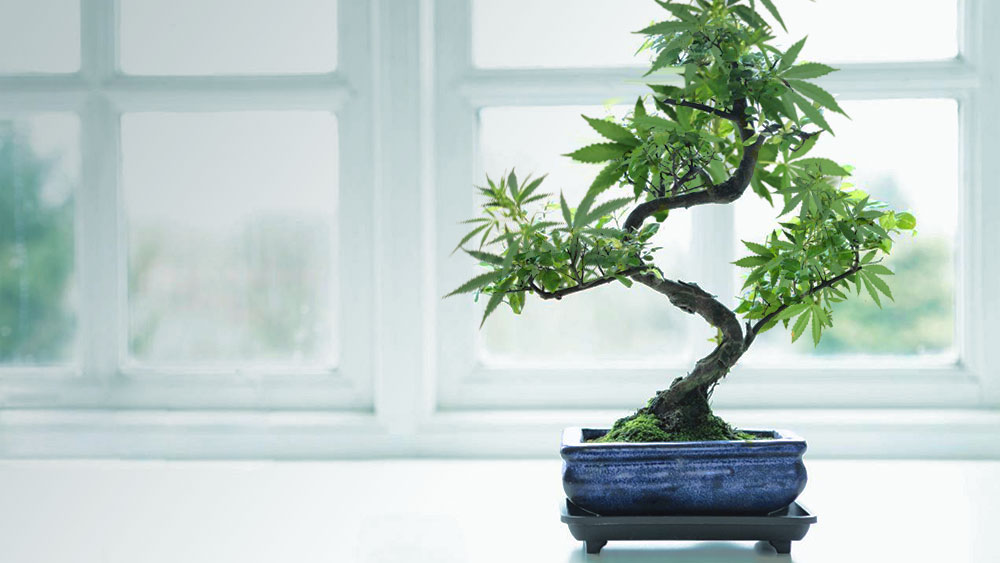


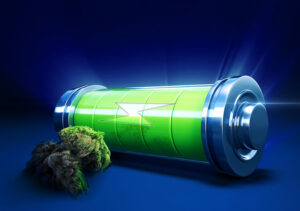
Veronika W May 26, 2018 at 1:38 am
This is super interesting! Maybe I will try it out...
Nicolai Pilgaard Andersen October 30, 2018 at 7:23 pm
How "young" does the plant need to be for startup?
Marco October 31, 2018 at 10:26 am
Hey Nicolai, it would be ideal for the plant to be around 2-3 weeks old to begin with manipulating the trunk and the branches, especially because of the trunk, as it has to be elastic in order for it to bend without braking.
aleasha May 26, 2020 at 10:55 am
can you start later on, mines about 6 weeks but was able to bend the branched the way in the photo posted
Greg P December 13, 2018 at 1:15 am
I think this article is a lot of fun, but it is weak on the bonsai side :) I would love to see a true guide on growing cannabis bonsai that could potentially win a bonsai award in an exhibit. This article is somewhat light-hearted, and I appreciate that someone is at least talking about the subject, but there is no mention of important subjects like pots, soil (different from what would be used in general cannabis cultivation), care (also different), etc. Growing cannabis for use, versus growing it for art are two different (though complimentary) goals.
Marco December 13, 2018 at 9:55 am
Thanks for your input Greg, but you should take into consideration that we have a limited amount of time for writing articles, especially for alternative topics such as this one. We have an entire section on growing https://greencamp.com/grow/ , and if someone is serious about growing a cannabis bonsai, I advise him/her to read numerous articles on this subject from different sources, because journalists generally have a time-frame that they have to follow.
sean May 9, 2020 at 2:20 am
I'll be that guy can you give me some of your additional sources for that great article as a disabled medical user i have one i van start with now its of unknown sex and between 8 and 12 weeks along but small
Marco Medic May 9, 2020 at 9:35 am
Hey Sean, check out these articles: https://greencamp.com/growing-weed/ https://greencamp.com/indoor-vs-outdoor-weed/ https://greencamp.com/feminized-seeds/
Karen Ciavarini May 10, 2020 at 2:17 am
Thank you. I have a plant ready to go. I'm going to read these now and then up pot it tomorrow on Mother's Day. She will be my new baby girl
Marco Medic May 10, 2020 at 10:28 am
I wish you the best of luck Karen ;)
john najjar May 1, 2021 at 10:13 am
Hi, This is an amazing article. If you continually regenerate a cannabis plant, the stem does het like a tree trunk. I would like to have a go at producing a beautiful Bonsai cannabis plant. I can see that this is something very new and innovative. My worry is that after putting so many hours into the plant, that it may die. I have had plants that we over 3 years old, and they looked amazing, but cannabis plants like us do get old and weak, too weak to fight off viruses, molds and bacteria, so that they die, after 2 to 3 years. To have them live that long one has too be very careful, and make sure all implements are sterile. True Bonsai can last for a very long time. I think, after all that work, I would be devastated if it died. What is the oldest Bonsai cannabis plant that you know about? Thank you for this very innovative and illuminating article.
Rovie May 18, 2020 at 9:01 pm
Don’t expect any Japanese true bonsai master to teach you any tips. Currently 5+ years in jail if convicted in Japan. YouTube it is for you hobbyists.
ANDREW C NORWOOD February 13, 2019 at 9:54 pm
What is your suggest source of light?
Marco February 14, 2019 at 3:52 pm
I'm a big fan of LED light Andrew, and I suggest you give this article a read https://420bigbud.com/led-vs-cfl-grow-light/
C May 9, 2020 at 11:25 am
Love led. Especially for such a small form factor of a bonsai. Great read!
Marco Medic May 9, 2020 at 12:01 pm
Thanks C
Gus April 2, 2019 at 8:14 am
Hi marco, i recently have started my own canabis bonsai, and i managed to lay te main brunch almost horizontally, but when i did so the flowering started, so my plant is really really small and already "bonsai looking" and flowering, iam really afraid of leaving the buds as it can get mold, and i am really afraid aswell of cutting the "mini buds" and killing my liltle baby, can you give me your suggestion, i will leave my email here for anyone who knows what to do, [email protected]
Marco April 2, 2019 at 9:02 am
Hey Gus, it's somewhat hard to determine anything without actually seeing the plant... You should probably trust your intuition here, and if you make a mess you'll know what to do next time :)
Sven April 13, 2019 at 8:16 pm
I love this. You did a great job simplifying the steps and making it easier for beginners to understand. Ive loved bonsai trees since i was 8 and my dad gave me one and ive loved kush since... well idk whenever i found out about it i guess lol but ive wanted to do this for a while now and this article is glorious. Thank u for the words of wisdom 😊
Marco April 15, 2019 at 8:40 am
Your kind words mean a lot Sven, and I also love bonsai trees, they're really gorgeous 😊
amirnajamsethit April 26, 2019 at 11:53 am
Thank you so much giving information about it. I bought one cannabis tree but i have no idea about how to grow it. Thank you for sharing information.
Marco April 30, 2019 at 9:15 am
I'm very happy to help ;)
Brandon September 4, 2019 at 12:26 am
That’s lovely! I also am a big fan of both elements involved, and out of curiosity just googled bonsai marijuana. My Pops used to have one growing in our backyard that we built a fort under it was so big. Not bonsai though. Good work. 👍
Marco Medic September 4, 2019 at 9:11 am
Pops and his fortress-plant both sound really dope :) Thank you for you sharing
Christopher Andrews November 22, 2019 at 10:02 am
It's very informative post. Keep sharing guys
Marco Medic November 22, 2019 at 12:48 pm
Tnx Chris.
Glenn Tamura January 31, 2020 at 4:02 pm
Hi Marco... Thanks... Great article. I'm working on a hydroponic Bonsai CBD Flower (no thc). If successful, I'll followup on the progress.
Marco Medic January 31, 2020 at 4:58 pm
Best of luck to you Glenn!
Karen Hovatter May 8, 2020 at 1:39 am
thank you. this is really interesting. i love those little trees. cannabis makes it even better.
Marco Medic May 8, 2020 at 9:17 am
thanks karen :)
Troy May 9, 2020 at 1:19 am
A great medium for these little trees is a modified Aero garden just remove the light so you can use one with a higher strength and there you go lovely aeroponic feed system
Walt Socha May 9, 2020 at 6:42 pm
New project...!
Jessi May 10, 2020 at 10:05 am
Cant wait to give this a go 🦄♥️🎄
Photoshop May 10, 2020 at 2:23 pm
Hello but i couldn't help noticing the Clumsy photoshop on the "Cannabis Bonsai Tree" photo that you have used as a Article Centerpiece.
Spanknrun May 14, 2020 at 12:40 am
It would be great if someone would do a video of this. 😎😉
Joe Velez May 15, 2020 at 4:51 pm
I have been growing one for almost a year as Bonsai but love to know what the best soil mix would be and most important watering. Also climate conditions especially winter . The mixture of soil I use for my Bonsai is Akadama,Pumice & lava rock
sarunas berzys January 26, 2021 at 6:58 am
Does smell stays strong as cannabins? I want to grow it for fun but i don't want my house to smell of cannabis.
Marco Medic January 26, 2021 at 2:26 pm
It's definitely not as potent, you should give it a go.
James July 25, 2021 at 11:36 am
Hi Marco Medic, I loved this article. I really learned something new today. Keep Sharing such articles.
Mo August 23, 2021 at 9:21 pm
Hi, loved the article. I've recently started experimenting and was wondering if it is necessary to top the plant?
Marco Medic August 25, 2021 at 10:52 am
Hey Mo, topping can't be considered as absolutely necessary, but it does help to extend the overall lifespan of your canna-bonsai, so therefore it's definitely advisable.
Green THumb January 6, 2022 at 3:05 am
can I do this with a non autoflowering seeding?